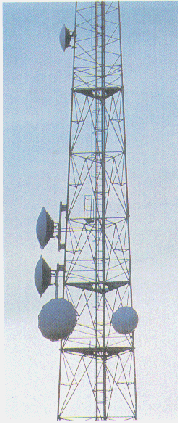

 One of the repeater stations that carry timing signals to the outlying telescopes and return astronomical data to Jodrell Bank. |
To operate an array like MERLIN, with its widely spaced, remotely controlled
telescopes, requires heavy investment in control and communication equipment.
The system devised for MERLIN is unique in the world. Three independent
channels link the telescopes to Jodrell Bank.
Control signals are transmitted over leased telephone lines between the control centre and the outlying telescope. Each of the telescopes has its own computer, a MicroCIRCE designed and built by Jodrell scientists, which is in constant communication with a master computer at Jodrell Bank. As well as ensuring that all the telescopes are working correctly and locked on to the required source position, the computers monitor the weather, the security of the site, and generally keep a watch over the telescopes in their charge. Any malfunction is immediately signalled to the control centre. |
| Astronomical signals are transmitted back to base by microwave radio
beams. All the telescopes in Cheshire are in a direct line of sight to
Jodrell Bank, but the more distant telescopes are connected through repeater
stations on high towers. The link to the furthest telescope, at Cambridge,
requires six separate hops.
The third channel, which also makes use of the repeater stations, is a radio link that transmits timing pulses from the atomic master clock at Jodrell Bank to each of the telescopes. Precise timing is essential if the astronomical signals are to be combined correctly. The pulses are received at each telescope are then sent back down the link to Jodrell Bank. The out-and-back travel time gives a measure of the effective path length between the telescopes, which can vary slightly according to atmospheric conditions. In this way corrections are applied to keep the "surface" of the imaginary 230-kilometre telescope aligned to a precision of 0.3 millimetres. |
 A Jodrell Bank technician uses a microscope to construct a high-frequency HEMT amplifier...  The completed amplifier... |
When the signals from outlying telescopes arrive at Jodrell they are combined, or "correlated", and the resulting information is stored on magnetic tape for later analysis. The correlator itself, the heart of the MERLIN system, was designed at Jodrell Bank and constructed by local industry.
To convert the correlated signals into useful information requires formidable computing power and ingenious software. Unlike conventional aperture synthesis arrays, the MERLIN telescopes are fixed with respect to each other and the baselines cannot be changed. So although the rotation of the Earth can be used to sweep out rings in the synthesised aperture, most of the aperture remains empty. Jodrell Bank astronomres have had to devise new computation techniques to handle data from this "unfilled aperture" and generate high quality images.
 The amplifier is installed in the receiver.(Chris Johnson). |
 Electronics for the MERLIN correlator designed using a Computer Aided Desgin system.(Chris Johnson). |
Jodrell Bank is fortunate in having access to the SERC Starlink network of astronomical computers, but the MERLIN workload is so high that a more powerful , dedicated machine is necessary. In 1987 Jodrell took delivery of an Alliant mini-supercomputer, which is big enough to take care of all MERLIN'S number-crunching for several years to come.

A circuit board from the MERLIN correlator. (Chris Johnson).